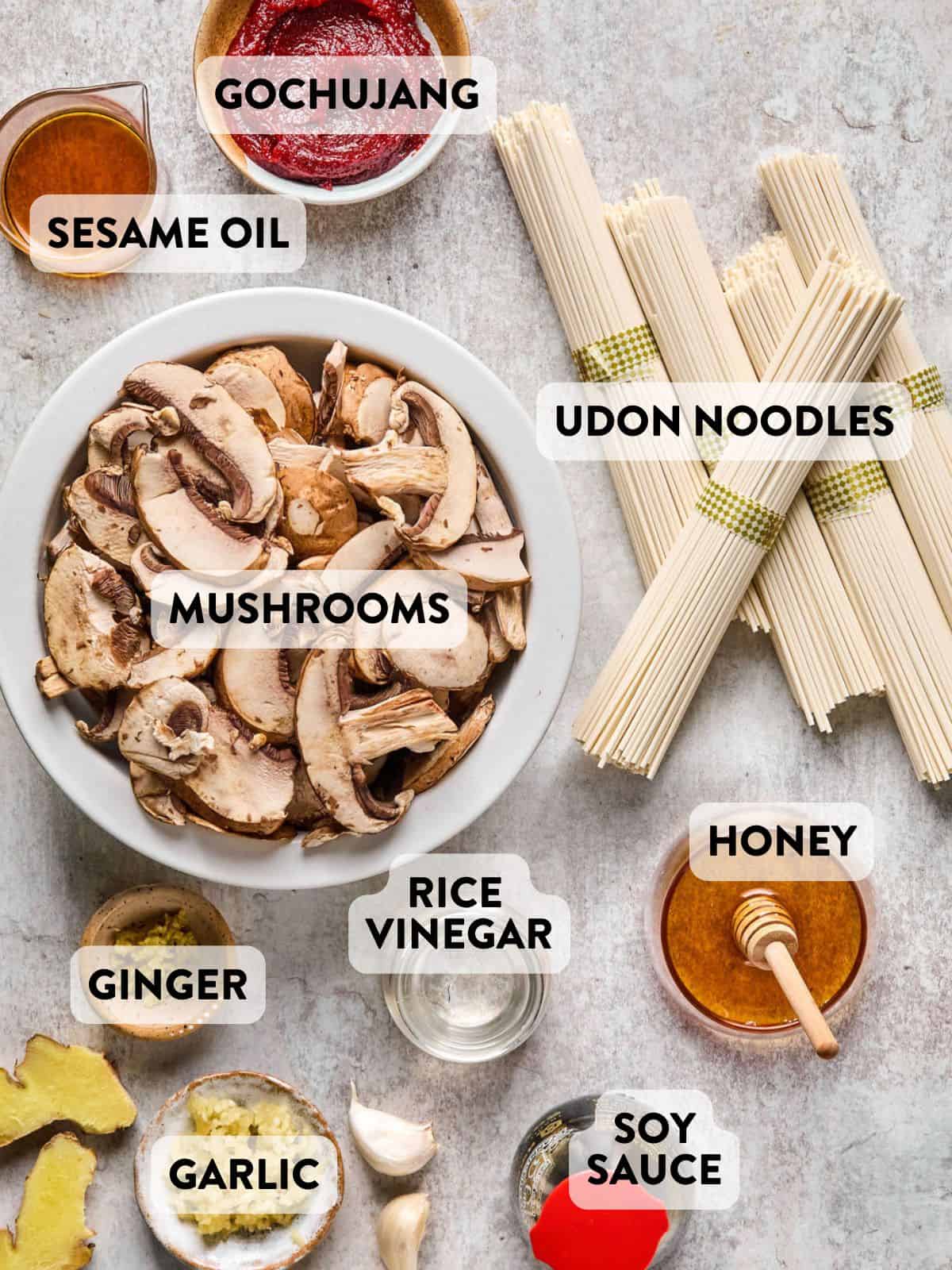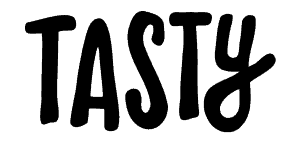These Spicy Gochujang Noodles are Loaded with Flavor
If you’re anything like me and crave a cozy bowl of spicy noodles, this recipe is going to be a regular in your rotation. The gochujang gives it that signature Korean heat and depth, balanced with just the right amount of sweetness and umami from soy sauce, sesame oil, and a touch of honey.
These noodles come together fast—like under 30 minutes fast—which makes them perfect for busy weeknights or whenever the craving for something saucy and slurpable hits.
Plus, the mushrooms soak up all that flavor and add a meaty, delicious texture. It’s one of those meals that you can throw in whatever veggies you have leftover in the fridge, so there’s no waste, and tons of flavor.

It’s fast, easy, and makes your weeknight dinner feel like takeout—but better. Similar to this healthy pad thai!
Need another Asian-inspired recipe? Try Asian chicken wings, or Korean shredded beef tacos.
Ingredient Notes

- Gochujang: Gochujang paste is a spicy fermented Korean chili paste. Learn more about what Gochujang is It isn’t typically gluten-free, but Sempio sells a gluten-free Gochujang paste. Where to buy: buy it in the International section of your grocery store. Or buy it online or in Asian markets.
- Noodles: Udon noodles are the classic chewy noodles for this recipe found in your local Asian market. You can use fresh, frozen, or dried udon noodles.
- Vegetables: Adding mushrooms gives this vegan dish a hearty feel. Use whatever veggies you have!
Gochujang Sauce Ingredients
- Reduced sodium tamari or soy sauce: I like to use tamari as a gluten-free option.
- Maple syrup or brown sugar: this balances out the heat.
- Sesame oil: It adds an Asian flare to the dish rather than traditional olive oil.
- Mirin: Mirin is a fermented rice wine vinegar with a funky, sweet, and acidic flavor. Use rice vinegar instead or try white wine vinegar, apple cider vinegar, or lime juice instead.
- Fresh garlic and ginger: adds just the right amount of zing.
- Tapioca starch: mixed in the sauce to thicken it.
See recipe card for full ingredients and amounts.
Recipe Variations
- More Vegetables: try adding baby bok choy, shredded napa cabbage, snap peas, or bell peppers to the mushrooms for a veggie-packed rice dish.
- Add protein: Try seared steak, chicken, shrimp, or tofu.
How to Make Gochujang Noodles

- Cook the noodles.

- Mix the sauce ingredients.

- Cook the mushrooms and pour the sauce on top.

- Stir in the cooked noodles.
Recipe FAQs
Gochujang is a spicy Korean chili paste made from red chili peppers, fermented soybeans, rice and salt. It is a result of the fermentation process and as a result, has a slight sweetness to it.
This ingredient can be found in the Asian or International food aisle of your local grocery store. You can also purchase it on Amazon. Be sure you’re buying the actual paste rather than the sauce. I made this mistake the first time we tested this!
There is a strong spice level to Gochujang because it’s made from red chilis. Use a tbsp or so less if you want the Gochujang noodles less spicy.

Storage
Allow the Gochujang noodles to cool completely then store them in an air tight container in the fridge for up to 5 days. Reheat on the stove over medium-high heat until warmed all the way through. You can also reheat them in the microwave in 30 second increments.
More Stir-Fry and Noodles
Gochujang Noodles
Save this Recipe!
Ingredients
Gochujang Sauce
- 1/2 cup soy sauce or tamari
- 1/4 cup honey or brown sugar
- 1-3 Tablespoons Gochujang paste (fermented Korean chili paste)
- 2 Tablespoons sesame oil
- 2 tablespoons Mirin or rice vinegar
Noodles and Vegetables
- 16 ounces udon noodles or rice noodles
- 2 tablespoons sesame oil
- 16 ounces baby bella mushrooms
- 1 teaspoon fresh grated ginger
- 4 cloves garlic minced
- Garnish: Thai basil, green onion, sesame seeds, or sriracha
Instructions
- Add the soy sauce, honey, gochujang, mirin, and sesame oil to a medium bowl and whisk well until the honey is combined and no longer thick and sticky.1/2 cup soy sauce, 1/4 cup honey, 1-3 Tablespoons Gochujang paste, 2 Tablespoons sesame oil, 2 tablespoons Mirin
- Cook the noodles in a large pot according to the package instructions. While they're cooking, finish the rest of the dish.16 ounces udon noodles
- Heat the sesame oil in a large skillet or wok over medium-high heat. Add the mushrooms when the oil is hot and begins to shimmer. Stir fry the mushrooms for 3-4 minutes, without stirring, to get them golden and crispy.2 tablespoons sesame oil, 16 ounces baby bella mushrooms
- Turn the heat down to medium and add the ginger and garlic and cook for 2-3 more minutes, stirring occasionally. Add 2 tablespoons of the prepared sauce and continue to cook for another 1-2 minutes until the mushrooms begin to cook down and caramelize.1 teaspoon fresh grated ginger, 4 cloves garlic
- Pour the remaining sauce into the skillet and bring to a simmer over medium heat. Reduce to medium-low and simmer to thicken, 2-3 minutes.
- Add the cooked and drained noodles to the sauce. Use tongs to toss them together until the noodles are completely coated, 1-2 minutes. Garnish with toasted sesame seeds, Thai basil, sliced green onion, chopped peanuts, or Thai red chiles before serving
Notes
Video
Nutrition
Nutrition information is automatically calculated, so should only be used as an approximation.
This post may contain affiliate links. Read our disclosure policy.











Amazing
Thanks Tracey!
My husband LOVES this! I found that just under a tablespoon of paste made it spicy enough for me to tolerate and I make a little extra sauce with more spice for him. Great recipe that’s PCOS friendly for me and Asian-inspired for him!
Thanks Grace! Glad you loved it!
So yummy! I added thin sliced beef but other than that made as is. Did 2.5 tablespoons of gochujang and that was plenty!
Ohhh yum sliced beef sounds delish!
Everyone ate this to my delight. We have a vegetarian, a pescatarian, & 2 meat-eaters, so this is rare. Unfortunately, I had to omit the mushrooms bc they had started to go bad, so I went with the matchstick carrots. Will try again with mushrooms next time.
Sounds yummy, Leah! Can’t wait to hear what you think about the mushrooms.
Made these two days in a row, with frozen vegetables from a bag! Cheap, quick and extremely delicious!